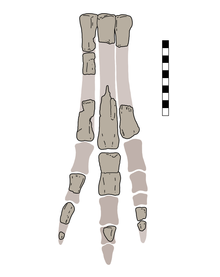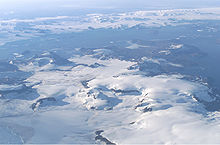Imperobator
| Imperobator | |
|---|---|

| |
| Reconstructed left hind limb | |
| Scientific classification | |
| Domain: | Eukaryota |
| Kingdom: | Animalia |
| Phylum: | Chordata |
| Clade: | Dinosauria |
| Clade: | Saurischia |
| Clade: | Theropoda |
| Clade: | Paraves |
| Genus: | †Imperobator Ely & Case, 2019 |
| Species: | †I. antarcticus
|
| Binomial name | |
| †Imperobator antarcticus Ely & Case, 2019
| |
Imperobator ("powerful warrior") is a genus of
Imperobator is one of the largest known paravians, with an estimated height of 2 metres (6.6 ft), making it of comparable size to the gigantic North American dromaeosaurs Utahraptor and Dakotaraptor. Its fossils lack the characteristic "sickle claw" on the second digit, excluding it from properly being considered a dromaeosaur by some research. Imperobator's lack of complete remains has caused controversy over its classification. It was described as a basal paravian by Ely & Case (2019), but a later study recovered it as a basal dromaeosaur.
It was discovered in the Cape Lamb Member strata of the Snow Hill Island Formation, which bears a variety of other fossils, many of them unique as they evolved in the isolation of Antarctica after the breakup of Gondwana. Imperobator coexisted with the ornithopod dinosaur Morrosaurus and bird Antarcticavis in addition to a menagerie of mosasaurs, plesiosaurs, and a pterosaur.
Discovery and naming

Fossils of a large theropod dinosaur were unearthed in December 2003 by a fossil hunting expedition that had been mounted by the
The fossils were first reported in published literature in 2005, with the authors theorizing that the specimen was of a "primitive holdover of the original Gondwanan dinosaur assemblage", noting its less derived characteristics compared to other Maastrichtian dromaeosaurs.[3][6] A more detailed paper on the theropod specimen was published in 2007, which believed that it was of a dromaeosaurid, dubbing it the "Naze dromaeosaur" after the site in which it was found.[1][7] The idea of the fossils being from a dromaeosaur was erroneous, as the pes lacked the distinct sickle claw in addition to other characteristics of dromaeosaurs.[2][1] The specimen was formally described as the holotype of a new genus and species, Imperobator antarcticus, by American paleontologists Ricardo Ely and Judd Case in 2019. The generic name derives from the Latin for “powerful warrior“. The specific name refers to the continent in which the specimen was discovered.[2]
Description
The holotype specimen measures approximately 45 cm in length, and it is estimated that Imperobator would have measured 2 m (6.6 ft) tall,
Leg
Imperobator is known only from fragmentary remains of the hindlimb, but it is still unique in several ways. The distal portion of the left tibia (shin bone) and some of the astragalus are preserved, though much of their characteristic features are missing due to erosion and frost. Both calcanea are preserved and are fused with the fibulae, a unique trait of the genus, with a fossa (shallow depression) on the internal surface of the calcanea for articulation with the astragalus. The calcanea have a circular, smooth surface divided by a groove running along its dorsal side. The left tarsal is longer anteroposteriorly than it is wide with a sub-triangular outline in anterior view.[2][1]
The metatarsals are preserved but are fragmented and broken. Of the ones preserved, metatarsals II and IV are broken into three pieces and metatarsal III into two pieces. Metatarsal V may be preserved, but it is not definitively stated by Ely & Case (2019). Metatarsal II is unique from that of other paravians in that it is parallelogram-shaped in cross-section, contrary to the circular or ovate forms in other genera. It also may preserve another diagnostic trait, a medial slant at the end of the diaphysis (midsection of the long bone), though this could be a pathological trait. Metatarsal III is heavily damaged but shows a symmetrical distal articular end and a triangle-shaped proximal end in anterior view, as in other paravians. The fourth metatarsal has a long ridge running along its posterior edge with a wider proximal end proportionally compared to the other metatarsals. The second pedal digit is incomplete, but a proximal half of phalanx II and the ungual is known from it. The third is represented by a proximal phalanx fragment, which is poorly preserved. A complete proximal-most phalanx of the fourth digit was also found. The incomplete ungual has a prominent flexor heel, a trait shared by the Romanian paravian Balaur bondoc.[2][9]
Classification
Before Imperobator was officially described, a paper published in 2007 announced the specimen and assigned it to the clade Dromaeosauridae; it was nicknamed the "Naze dromaeosaur".[1] This was problematic as UCMP 276000 lacked multiple characteristics of dromaeosaurids, including a prominent sickle claw, and the paper naming and describing Imperobator assigned it only to the clade Paraves.[2] During the formal description of Imperobator, the authors recovered this taxon as a paravian theropod, related to smaller members of the group:[2]
Later in 2019 Scott Hartman and team in their description of
Paleoenvironment
Imperobator's fossils bear some surface weathering and abrasion, which indicate that they have gone through minimal transport, reworking, and sub-aerial weathering.
References
- ^ .
- ^ S2CID 146325060.
- ^ a b Martin, James; Case, Judd (2005). "Fossil hunting in Antarctica". Geotimes Magazine. pp. 18–21.
- ^ a b c d e f Lamanna, Matthew; Case, Judd; Roberts, Eric; Arbour, Victoria (2019). "Late Cretaceous non-avian dinosaurs from the James Ross Basin, Antarctica: description of new material, updated synthesis, biostratigraphy, and paleobiogeography". Advances in Polar Science. 30 (3): 228–250.
- ^ Lamanna, O'Connor, Salisbury, Gorscak, Clarke, MacPhee, Roberts, Malinzak, Ely and Case, (2017). New material of non-avian dinosaurs from the Late Cretaceous of James Ross Island, Antarctica. Journal of Vertebrate Paleontology. Program and Abstracts 2017, 147.
- ^ a b c d Mortimer, Mickey. "Troodontidae". The Theropoda Database. Archived from the original on 5 Jan 2023. Retrieved 2023-05-26.
- S2CID 130027429.
- PMID 19816582.
- S2CID 59932467.
- PMID 31333906.
- ^ Smith, N. D., Makovicky, P. J., Pol, D., Hammer, W. R., & Currie, P. J. (2007). The dinosaurs of the Early Jurassic Hanson Formation of the central Transantarctic Mountains: phylogenetic review and synthesis. US Geological Survey and the National Academies, Short Research Paper, 3.
- ^ S2CID 249359371.
- .
- ^ Salgado, L.; Gasparini, Z. (2006). "Reappraisal of an ankylosaurian dinosaur from the Upper Cretaceous of James Ross Island (Antarctica)" (PDF). Geodiversitas. 28 (1): 119–135. Archived (PDF) from the original on 2023-05-21.
- PMID 26261324.
- PMID 30924945.
- S2CID 213442204.
- hdl:11336/53690.
- S2CID 208642733.
- S2CID 128965534.
- ^ S2CID 129228056.
- ^ a b Martin, J. E., Bell Jr, G. L., Case, J. A., Chaney, D. S., Fernández, M. A., Gasparini, Z., ... & Woodburne, M. O. (2002). Mosasaurs (Reptilia) from the Late Cretaceous of the Antarctic peninsula. In Antarctica at the Close of a Millennium, Eighth International Symposium on Antarctic Earth Sciences. Royal Society, New Zealand Bulletin (Vol. 35, pp. 293-299).
- ISSN 0031-0182.
